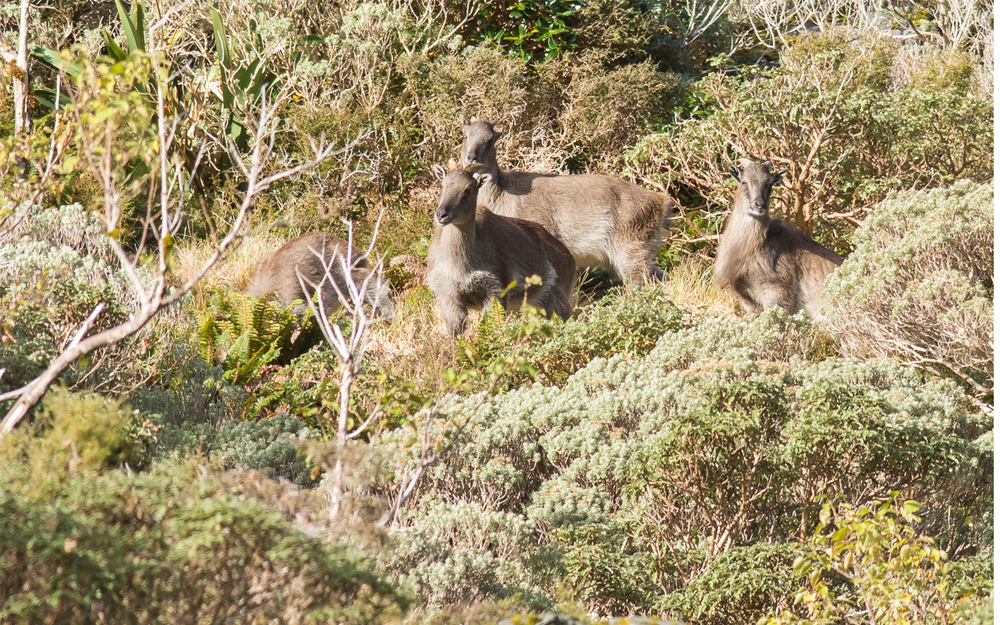Court orders more tahr talks
Marjorie Cook
13 July 2020, 1:06 AM
 Tahr eating vegetation. PHOTO: Department of Conservation
Tahr eating vegetation. PHOTO: Department of ConservationThe Department of Conservation has welcomed a decision by Wellington High Court Justice Dobson that will allow the department to begin culling Himalayan tahr from southern National Parks this month.
However, DOC may only complete half of its 2020 tahr cull programme for now.
Justice Dobson has directed DOC to go back to the New Zealand Tahr Foundation and other stakeholders and consult again on its operational cull programme before the job can be finished.
DOC operations director Dr Ben Reddiex said the department was pleased it could now start “important control work to protect New Zealand’s alpine environment”.
The Tahr Foundation last week sought an urgent judicial review of DOC’s 2020 cull, which has a $700,000 budget and is scheduled to run for 250 hours from July 1.
DOC is targeting an estimated 7500 tahr, including bull tahr, this year. The final level of control is now up for discussion.

Himalayan tahr were introduced to New Zealand in 1903.
When DOC decided in late June to embark on the relatively large-scale cull using contracted helicopter-borne hunters, the foundation was shocked it was given only two days to comment on the final plan.
The Tahr Foundation claimed the plan was outside the law and DOC's plans and policies; that DOC failed to consult properly; and that during earlier talks, DOC had asked the wrong questions of stakeholders and was therefore acting on inadequate information.
Justice Dobson rejected most of the foundation’s case but found “there was a partial inadequacy by DOC" to consult about the extent of the cull.
He noted a longstanding practice of consultation, which had been disrupted by Covid-19 restrictions.
He considered there was an “element of overstatement in some of the claim" but accepted “the manner in which that critical ingredient of the proposed plan was conveyed left hunting interests with inadequate time to make a full response on the implications of the extent of culling".
Quashing DOC’s decision to adopt the plan would be disproportionate and was not warranted, Justice Dobson said.
In autumn 2019, the tahr population was approximately 34,500, on public conservation land alone.
DOC, commercial hunters and contractors then culled about 11,000 tahr between July to November. There has since been a breeding season and DOC wants to reduce the herd again before another breeding season begins.
“We know there are significant populations on private land and Crown pastoral leases. There are simply too many tahr and our unique alpine ecosystems are at risk," Dr Reddiex said.
The Tahr Foundation had claimed the control work would affect the commercial hunting industry, said to be worth about $100 million, and both the commercial and recreational hunting sectors were concerned that DOC would target sought-after bull tahr, which the foundation claimed had not been DOC’s previous policy.
Justice Dobson said it was not mandatory for DOC to consider the interests of the commercial hunting industry under any laws, policies or plans. He also said DOC had flagged a change in dispensation given to hunters on bull tahr and the foundation had been given ample time to prepare a submission on that aspect.
Dr Reddiex said DOC’s planned control work would have a minimal effect on the commercial hunting industry, which mostly operates outside of public conservation land.
Data from trophy exports between 2014 and 2016, indicated on average, 1000 to 1100 commercially hunted bull tahr leave the country each year.
“Concession returns show just 316 trophy bull tahr are commercially hunted on the conservation estate annually, and less than a hundred of those are taken from the national parks,’’ Dr Reddiex said.
AG | TRADES & SUPPLIES
FOOD | DRINK




